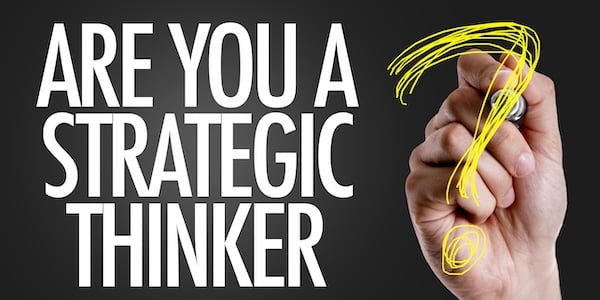Is Context the Missing Piece in Your Strategic Thinking?
Let me know if any of this rings true for you.

Strategic thinking capabilities have been discovered!
Today's complexity means that decision-making needs to happen closer to the action. So, managers need to depend on their teams to make the right evaluations as they keep pace. Making those evaluations in alignment with current priorities and an organization's long-range goals is applied strategic thinking.
Strategic thinking combines creativity, innovation, and research to create a significant competitive advantage in today’s fast-paced, ever-changing world.
Unfortunately, these important capabilities do not appear on their own.
They are the result of conscious steps to foster them and make them a part of a strategic management process. So, what exactly makes up strategic thinking, and how can you tell if you are building it into your operations?
With over 25 years of working with organizations to build and execute their strategic plans, we have found five core elements in our most successful clients. Understanding and incorporating these elements into how you operate ultimately leads to stronger strategic thinking skills.
The five core elements needed to build your strategic thinking capabilities:
An outward orientation means taking an ‘outside in’ approach to evaluating what you are doing. It means looking at your activities in relation to things outside of your department or organization. It is the opposite of operating in isolation. An outward orientation affords you the opportunity to look beyond what you can currently see and even beyond the needs of your customers to seek the influences at work in your environment. With an outward orientation, you will be better prepared to understand what you are a part of and how to make proactive steps to act more effectively now and in the future.
Context is necessary to evaluate opportunities, insights, or performance in real time. This context comes from a well-understood long-range criteria for decision-making.
When teams have this context or direction it provides confidence to make necessary changes when you might be spinning your wheels or moving away from your ideal destination. Let me be clear, today’s wish list does not establish your long-range criteria. It is derived from a clearly defined vision of success. In other words, it is part of your overall strategic direction. You must know what success looks like before you can define the criteria, but then you must use it regularly in decision-making.
A realistic and aggressive story is one that pulls together the elements of what you are doing now with how you will evolve over time to get to where you ultimately want to go as an organization. For honoring great performance, shifting priorities and inspiring future commitment, there is nothing like a compelling story that people believe in. To have great thinking, you must capture the imagination to unleash their creativity. Think about the master corporate storyteller, Steve Jobs. Although your story doesn’t have to set out to change the world the way Apple’s did, it should inspire, excite and motivate you and your team. It should define a pathway forward that is both relevant to today’s challenges, and aggressive enough to inspire others to act in ways that take you to the next level.
Another key element is how new ideas can be received, evaluated, and either discarded or integrated into current priorities.
This sort of deliberation is accomplished through a pragmatic, structured, and disciplined management process.
Pragmatic, in that you start with your current focus and incorporate new thinking into it rather than letting a new idea derail your current focus. Structured, in that people understand how decisions are made, what roles are in this process, and how to participate effectively in it. And disciplined, meaning that it is part of the company’s regular management process. It is as core to how you manage as hiring practices or budgeting. It does not go away when a new manager is hired, or new priorities are established.
A high comfort level with a dual focus means being laser-focused on executing your current priorities (the deliberate set of objectives and strategies that make up your plan) and openness and flexibility to the exploration of emerging ideas. This is probably the most challenging element for leadership teams. The dual focus often creates tension between executing a plan perfectly (for which you might be rewarded) and the possibility that, at any stage, as new ideas emerge, the plan might shift. Having a pragmatic, structured, and disciplined management system can significantly increase the comfort level with a dual focus, but in my experience, it is not enough. The leadership team must be comfortable with the sometimes-awkward nature of a dual focus: perfect execution of deliberate strategies and flexibility to integrate emerging strategies when necessary.

Let me know if any of this rings true for you.

Strategic thinking skills are in demand, and no wonder. The complexity within which we operate demands that many strategic decisions be made in...

For years, “strategic thinking” has been reserved for executive team meetings or board rooms as part of a firm’s strategic planning process. However,...